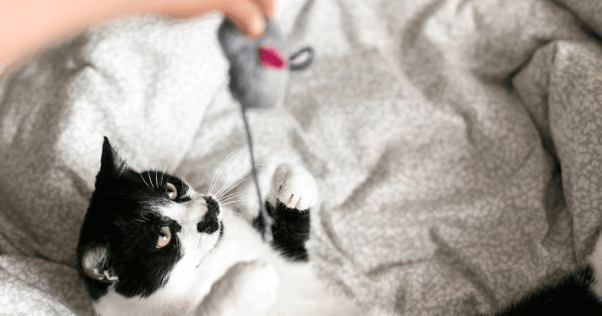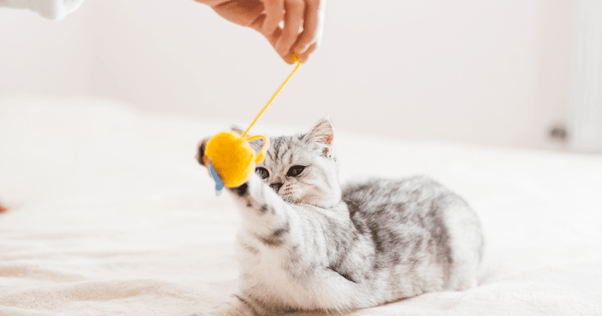How to Play with Your Cat - 5 Fun Activities!
Have you ever watched your feline friend entertaining themselves in the garden - patting a fluttering leaf, chasing a bug, climbing a tree or hiding behind a bush ready to pounce? It’s what their ancestors did in the wild, though at that time they were not only playing, they were also surviving.
Our beautiful cats still have these instincts, except now these activities are part of what keeps our cats active and mentally stimulated. Although sometimes they will still chase and catch their prey, and feel very pleased with themselves that they are still using their hunting behaviors!
We can take advantage of these instincts when we are playing with our cats. Learning some fun activities you can do together will not only strengthen your bond, it will ensure they are kept physically and mentally stimulated.
How to Play with your Cat
Try out these 5 fun activities that will bring out your cat’s instinctive hunting behaviors - but try to keep your play sessions fairly short so they don’t lose interest!
No more than 15 minutes - and at dawn or dusk, when they are at their most active, is ideal. Being crepuscular is the biological category for animals who are most active at dawn and dusk - and cats fall into this category. So unless you feel like playing games very early in the morning, you might want to schedule regular playtimes at dusk instead!
5 Fun Activities that take advantage of their instincts
1. Searching
Hide and seek will always be a winner. Try hiding your cat’s favorite toy behind a cushion for them to find or stuff some kibble inside a cardboard tube for your cat to search and find - this will reinforce positive play as they know they will find something tasty at the end.
You could also try hiding and be the one to be found! If you hide and call them, have some treats with you to reward your cat when they find you, this will encourage them to repeat the game. This could also be useful when you need to call your cat into the house, or to get their attention, so teaching this game could have a double benefit!
2. Stalking
Cats love to stalk, but remember that their playtime ‘prey’ should move unpredictably - sometimes it will crawl slowly along the ground, sometimes it will dart across the floor, or jump over an obstacle. A toy mouse on the end of a string will help your kitty mimic their stalking instincts. You will see them crawl along the floor very slowly until they are in a good position to pounce on their prey.
When using a prey-like toy with your cat, remember to mimic the prey too! For example, prey wouldn’t come up close to your cat, so don’t put the toy too close; remember that an object within 30 cm is not clear to a cat (that’s when their super-sensitive whiskers come in to play) so put their ‘prey’ at a distance where they can stalk it and see it when it starts to move - perhaps partially hidden behind some furniture.
3. Pouncing
Your cat will probably stalk and crouch down in the same place for a few seconds before they pounce! Don’t mistake their waiting time for disinterest; they are just carefully assessing the situation and they will pounce when they judge the time is right!
4. Chasing
A ping-pong ball rolled along the ground is a great attraction to a cat. Once they catch up with it, they will probably pat it so that it moves away again, and have great fun chasing it. Alternatively, some cats will enjoy chasing when you throw a ball up the stairs - they will get lots of climbing exercise with this game too and it's great fun to watch them try to catch it when it bounces back down.
5. Catching
A fishing rod dangling a toy that they can reach when standing on their back legs is a great game of catch - but always allow your cat to ‘catch’ it with their paws. If the toy is too high and out of their reach, they will quickly get frustrated and stop playing.

Things to consider and remember when playing with your cat
- All cats are different and what might work for one cat, might not work for another - it will be trial and error!
- If you have more than one cat in your household, make sure you put aside some playtime for each one, individually.
- Your cat might just not feel like playing - so don’t try and force them. Cats like to make their own choices. They are also creatures of habit, so schedule some playtime into their routine and they will often play ball.
- Always end your play sessions on a positive note, for example, your cat ‘catches’ the toy, or they always find a treat.
- Dispose of any damaged toys and check for any potential hazards such as string. String is fine to play with when your cat is being supervised, but can be a hazard if your cat gets tangled in it or tries to eat it.
- When playtime has finished, put the toys you share with them away, so they won’t be tempted to play with them outside of your dedicated playtime and get bored. This will keep their interest and the toys will be associated with your bonding time. You could leave them with a different toy, such as a ball, to bat around while you are busy however!
- Regularly change their toys. Make playtime different by focusing on different natural instincts - one day you could play hide & seek, another day you could hone their stalking skills!
- Remember that as they grow, how cats play changes. Younger cats will probably have more energy (and interest) in playtime, but older cats may prefer your bonding time to include grooming, a tummy rub or more gentle play for a shorter period.
- Don’t use your hands or feet as toys; you may find it cute when your cat is a kitten and their bite is not strong, but as they get older, they will get stronger and more painful. This is particularly important to stress to younger members of the family.
- You don’t have to spend lots of money on toys! Cats are very happy with cardboard boxes, plastic bottles, cardboard tubes and balls of string or wool. A cardboard box can be made into a comfy bed, a hiding place, or a den with a bit of imagination and your cat will love you for it!
- Combine playtime with training. Teaching your cat something that might otherwise be a challenge for them (like being groomed, or their association with a cat carrier) could be turned into a game. This could be combined with a play session, and could certainly pay off!
- Cats won’t want to play if they feel anxious or stressed. To ensure your cat is always relaxed and happy, try using FELIWAY CLASSIC in the home; it helps create an environment o enhanced serenity, so playtime could become a regular occurrence!

Getting it right - what do cats like in a toy?
There are a number of things that can influence whether a cat will play with, or turn its whiskers up at, a toy. These can include the shape and size, how it smells, how it moves or if it’s noisy or not!
Cats generally like toys that:
- Move quickly and in unpredictable ways - there are some amazing electronic interactive toys available
- Mimic their prey, particularly if they are mouse-like
- Have different textures, like patchwork toys
- Have a noise - but not ones that might startle them. A bell, or a low buzzing sound, like a fly or a bee!
- Make them feel euphoric, like catnip!
- Reflect light - a laser pen shone around the floor works a treat. Just make sure your kitty is able to end the game on catching something, as sometimes laser play can leave cats feeling frustrated.
And remember, cats need to be in the right frame of mind to interact and if there’s anything making them feel restless or anxious, they may just not want to join in with the fun.
